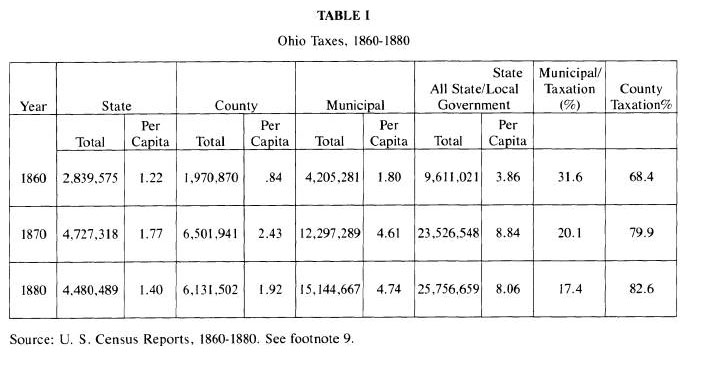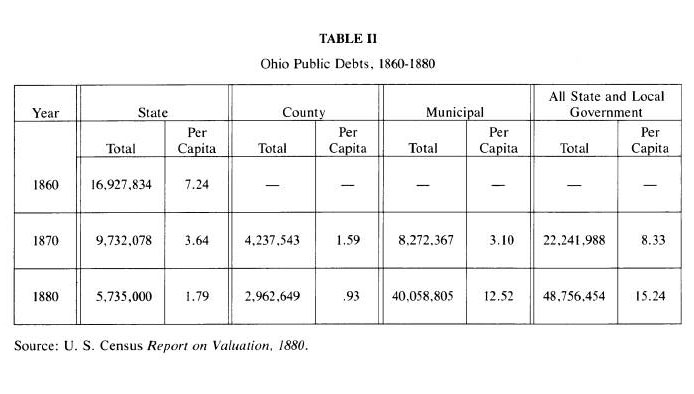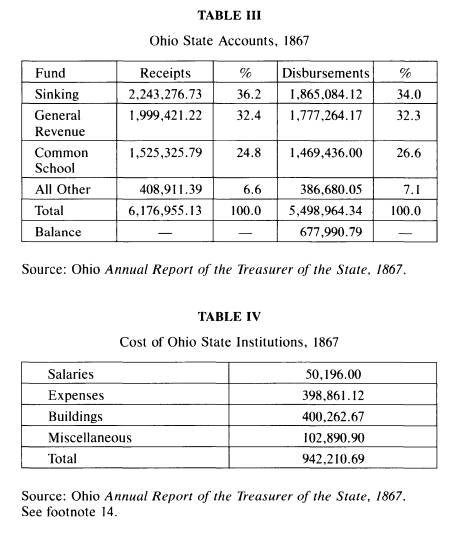Ohio History Journal
74 OHIO
HISTORY
and midwestern conditions.4 Moreover,
there survives an excellent
combination of materials describing the
topic in the state documents,
which outline the structure of public
finance and inspection, in the
BOSC reports (written by Byers), which
graphically portray condi-
tions in the institutions and conflicts
between local governments and
the state authorities, and in Albert
Byers's own diaries and a brief
but interesting file of letters sent to
him in his official capacity.5 When
these materials are used in conjunction
with the annual reports of the
National Conference of Charities and
Correction, it becomes possible
to reconstruct what we think is an
illustrative portrait of the formative
period of state welfare.
The bill creating the Ohio Board of
State Charities in 1867 was ad-
vocated by Republican Party reformers
who controlled state politics
for the better part of two decades,
beginning in 1855 with Salmon P.
Chase's election as governor.6 Three-time
governor, and later Presi-
dent, Rutherford B. Hayes was the other
major figure in this group.
The reform faith that the state should
encourage education, relieve
disease, reform the wayward and aid the
victims of war had pro-
duced a substantial number of
institutions by the end of the Civil
War. Three insane asylums, a
penitentiary, a blind asylum, a reform
school for boys, a deaf and dumb asylum,
and an institution for the
"idiotic" were in operation
while a fourth insane asylum, a soldiers'
home, and a soldiers and sailors'
orphans home were about to open.
There was active discussion on the need
for a girls' reform school
4. Few southern states created charity
inspection authorities before 1900, largely
because the number of institutions to
inspect was so small. By the late 1920s, however,
with southern urbanization and
industrialization well underway, Sophonisba P. Breck-
inridge reported "central
supervisory authority" in all but three states (Mississippi,
Nevada and Utah) and everywhere a trend
toward increasing the coercive power of this
authority. See Sophonisba P.
Breckenridge, "Frontiers of Control in Public Welfare Ad-
ministration," Social Service
Reviews, 1 (1927), 84-99. For further evidence of Ohio's typ-
icality see Robert H. Bremner, ed., Children
and Youth in America, I (Cambridge, 1970),
639-50; Ibid., II. 250-58:
Sophonisba P. Breckinridge, ed., Public Welfare Administration
in the United States: Selected
Documents, Second Edition (Chicago,
1938), 237-364.
5. A series of diaries belonging to
Byers are in box 5 of the Janney Family Papers,
Ohio Historical Society (OHS). He seems
to have used them as an aide-memoire and
they consist largely of brief factual
entries and a meticulous detailing of expenses. Subse-
quently, some of them were used for
other purposes, the 1864 volume, for example, for
press clippings from 1868. These in turn
have been annotated, probably much later to
judge from the hand. See also notes 21
and 37.
6. Ohio. Laws. LXIV (1867)
257-58: Ohio. House Journal (1867), 624. Ohio was the
third state to establish a charity
board, following Massachusetts (1863) and New York
(earlier in 1867). Seven other states
(North Carolina, Illinois, Rhode Island, Wisconsin,
Michigan, Connecticut and Kansas)
followed suit by 1873. For an excellent summary of
the various circumstances shaping the
development of these boards, see Gerald N.
Grob, Mental Institutions in America:
Social Policy to 1875 (New York, 1973), 270-92.
Origins of Welfare
75
and an "intermediate"
reformatory for male first offenders. In addi-
tion, the state paid annual subsidies to
the Longview Insane Asylum
(Cincinnati), Miami University and Ohio
University, while further ex-
penditures were likely as Civil War
veterans aged and as the state re-
sponded to the Morrill Act, which
granted to states the proceeds of
federal land sales for the establishment
of public colleges and univer-
sities. It must be added that although
these institutions were cre-
ated by one political faction, their
incorporation, like that of the
BOSC, received broad bipartisan
legislative support.7
But why was it necessary to create a state
authority to inspect pub-
lic institutions? Two reasons stand out.
First, legislators, pressured by
local philanthropic groups, had been
forced to take cognizance of
the generally dreadful conditions of
county and municipal jails and
infirmaries (almshouses). As the
incorporator of these governments,
the state had a legal obligation to
inspect their institutions and to pre-
vent cruel treatment and neglect.
Second, and of greater concern, leg-
islators felt increasingly unable to
control costs and monitor condi-
tions in the state institutions. A state
board of charity would, it was
hoped, bring local institutions up to
minimal standards, whittle
down the budgetary requests of the
various state institution trustee
boards and root out corruption wherever
found.8
A brief analysis of the financial and
governmental structure of late
nineteenth-century Ohio provides
pertinent background information
on these problems and thus the means for
explaining why the mis-
sion of BOSC was substantially
compromised from the outset. We be-
gin with two generalizations: First,
local government (that is, coun-
ties, townships, municipalities and
school districts) raised and spent
most of the public monies. Second,
though state expenditures were
therefore relatively small, a
significant and growing proportion of its
budget was devoted to education and
welfare expenses. Both of
these points require development.
Table I, a summary of taxes collected by
local and state govern-
ment from 1860 to 1880, indicates the
local predominance.9 In 1860
7. For an example of legislative
approval of institutions, see Robert M. Mennel, "The
Family System of Common Farmers': The
Origins of Ohio's Reform Farm, 1840-58,"
Ohio History, LXXXIX (Spring, 1980), 131-34.
8. Ohio. House Journal (1867),
204-35, 624 and appendix, 235-37. An analysis of cor-
ruption at the state level is John P.
Resch, "The Ohio Adult Penal System, 1850-1900: A
Case Study in the Failure of
Institutional Reform," Ohio History, LXXXI (Autumn,
1972), 236-63.
9. Table I drawn from the following
sources: U.S. Census. Statistics of the United
|
76 OHIO HISTORY |
|
Origins of Welfare 77 |
78 OHIO HISTORY
county and municipal taxes were twice as
high as state taxes and the
difference increased during the decade.
County taxes increased at an
average annual rate of 23 percent, while
the municipal increase was
nearly 20 percent. County and municipal
taxation combined to ac-
count for over 80 percent of all public
levies by 1870, a proportion
which held steady in 1880 (and even into
the twentieth century).10
For state taxes the average annual
increase during the 1860s was less
than 7 percent, and the state percentage
of all taxation shrank from 32
to 20 percent, a share that declined
further by 1880. The municipal
burden remained the most substantial,
increasing during the 1870s
on both a total and a per capita basis,
while state and county taxes
decreased in both categories.
Table II, Ohio Public Debt from 1860 to
1880, emphasizes the
stress on municipalities. The figures
clearly show debt declining at
the state and county level while
climbing sharply in the towns and
cities.11 This was due, on the one hand,
to the retirement of state ca-
nal bonds and the completion of county
jails and infirmaries, and on
the other hand, to the capital
expenditures for the schools and pub-
lic works needed to meet the demands of
an urbanizing population.12
Although state taxation and debt were
declining in relation to local
burdens, welfare spending was creating
pressure upon available reve-
nue. The structure of state finance is
illustrated in Table III; 1867 is an
apt year since the BOSC was established
then. Of a series of separate
funds, whose income and expenditure were
kept independent from
each other, the three most important
were the Sinking Fund, the
General Revenue Fund, and the Common
School Fund. In 1867,
these funds accounted for more than 90
percent of both receipts and
disbursements.13
General revenue was the crucial account.
Representing about a
States in 1860. Mortality and
Miscellaneous Statistics (Washingtion,
D.C., 1866), 511;
U.S. Census, Eighth Census. The
Statistics of Wealth and Industry of the United States
(Washington, D.C., 1872), 11, 51; U.S.
Census. Ninth Census. Report on Valuation, Tax-
ation and Public Indebtedness in the
United States (Washington, D.C.,
1884), 25.
10. U.S. Census Bureau. Wealth, Debt
and Taxation (Washington, D.C., 1907), 767,
967-69. Ohio law allowed county
commissioners to hire "tax inquisitors" to pursue
evaders. The inquisitors were paid a
percentage of the amount they enabled the govern-
ment to recover.
11. U.S. Census. Ninth Census. Report
on Valuation .., 284-85, 612-13. County
and municipal figures are unavailable
for 1860.
12. These taxation and spending patterns
followed national trends. See U.S. Census
Bureau. Wealth, Debt and Taxation,
1913 (Washington, D.C., 1915). On the impact of ca-
nal building on Ohio finance see Harry
Scheiber, Ohio Canal Era; A Case Study of Gov-
ernment and the Economy, 1820-1861 (Athens, Ohio, 1969).
13. Ohio. Annual Report of the
Treasure of State (1867), 9.
|
Origins of Welfare 79 |
|
|
|
third of the total budget, it was supported by a general property tax and met the day to day running expenses of the state government. Its major commitments were salaries, legislative costs, and the expenses of the state institutions. Institutional costs, outlined in Table IV, made a decisive impact upon the state budget. In 1867, institutional build- ing and operating expenses accounted for 53 percent of disburse- ments from the General Revenue Fund-that is, more than than half the everyday operating costs of the state government-and 17 percent |
80 OHIO HISTORY
of disbursements from all funds.14 More
important, these costs
could not be controlled as easily as the
state's other major obliga-
tions, the Sinking Fund and the Common
School Fund. Although
these two funds accounted for 60 percent
of total disbursements in
1867, the Sinking Fund was declining in
importance as the canal
bonds were paid off while school
expenses were curtailed by the re-
quirement that localities bear the brunt
of costs. By contrast, legisla-
tors were annually beseiged for funds by
institutional trustees with
costs escalating to the point that
several delegates to the State Consti-
tutional Convention of 1873 feared state
insolvency.15
The situation was further complicated by
the fact that appointment
of institutional trusteeships
represented one of the few sources of pa-
tronage for the state's chief executive.
The state constitution denied
the governor a veto and allowed him only
a few appointments. Even
the trustee appointments had to be
confirmed by the state senate.
Thus, with each change of
administration, "reorganization" of trus-
tee boards was always a possibility.
Institutional trusteeships were
highly priced even though unpaid. Not
much could be made from
per diem expenses, but the offices conferred or recognized
status,
carried their own appointing power over
institution staff, and even
though trustees were barred from direct
commercial connection with
their institutions, they did determine
the placing of contracts. The
net effect was to create support for the
institutions and their programs
in both the legislative and executive
branches and thus dilute the
impact of cost cutting and efficiency campaigns.16
Given both the preponderance of local
government and the politi-
cal power of state institutions, it was
no surprise that in debate on the
bill to set up the Board of State
Charities, legislators weakened the
draft in order to protect their own
financial and political interests, to
cut costs and to leave patronage
undisturbed. The original bill pro-
vided the board with the services of a
modestly paid executive sec-
retary who was empowered to:
14. Figures recombined from the detailed
list of disbursements from the General
Revenue fund, Annual Report of the
Treasurer of State (1867), 12-15. This detailed listing
gives a total differing from that of the
summary recapitulation reproduced as Table III.
The recombination here has used the
detailed listing.
15. Ohio. Official Report of the
Proceedings and Debates of the Third Constitutional
Convention, I, part 3 (Cleveland, 1873-74), 200-38.
16. Most of the surviving Governors'
Correspondence for this period in the Ohio
State Archives is closely concerned with
patronage. Though fragmentary and damaged
by fire, these files are a mine of
tantalizing information.
Origins of Welfare 81
investigate and supervise the whole
system of the public charitable and cor-
rectional institutions of the state, and
counties, and shall recommend such
changes and additional provision as they
may deem necessary for their eco-
nomical and efficient administration.17
In the legislative give and take,
however, the words "supervise" and
"counties" were deleted,
leaving trustee boards unchallenged and
the localities subject to discretionary
rather than mandatory visits.
The power to inspect technically
remained because the state char-
tered local government and occasionally
subsidized local institutions,
but with the additional removal of the
provision for a paid secretary
the likelihood of regular inspections
appeared remote.
The law that emerged from debate, then,
confined the Board of
State Charities (whose members were to
draw only expenses) to visi-
tation and the gathering of information.
In this respect, the BOSC
was treated only slightly worse than
other state agencies. The Gas
Commissioner and the Inspector of Steam
Boilers had to use their
salaries and personal funds to purchase
testing equipment, while the
Inspector of Mines pleaded in vain for
one assistant to help him con-
duct inspections.18 In short,
these early boards and commissioners
were armed mainly with the weapon of
publicity. Personal conviction
and administrative skill would be the ingredients
of whatever suc-
cess they might achieve.
The first trustees of the Board of State
Charities suitably repre-
sented the reform wing of the Republican
party. Foremost among
Governor Jacob Cox's appointees in 1867
was Joseph Perkins, a
Cleveland banker, philanthropist and
railroad founder. Robert W.
Steele of Dayton helped organize the
first state agricultural fair and
tirelessly promoted public libraries and
higher education. Douglas
Putnam of Marietta had a distinguished
Civil War record and, like
the others, had formed his allegiance to
the Republican Party in the
anti-Nebraska agitation of the
mid-1850s. The other major figure of
the early board was John W. Andrews, a
Columbus lawyer who was
appointed by Governor Rutherford B.
Hayes in 1870. Representing
different parts of the state, these men
were united in belief-as Prot-
estants (Presbyterians or
Congregationalists) valuing good works as a
path to salvation and as Republicans who
saw their party as symbol-
izing God's blessing of the American
people.19
17. Ohio. Senate Journal (1867),
624.
18. Ohio. Docs. I (1867), 247-56;
Ibid., I (1870), 579, 583, Ibid., II(1876), 81-82.
19. Elroy M. Avery, A History of
Cleveland and its Environs, I (Chicago, 1918), 252,
337; The History of Montgomery
County, Ohio (Chicago, 1882), 244-45; History of
82 OHIO HISTORY
The trustees defined their primary task
as soliciting funds from
"private but influential
citizens" in order to pay the salary of an agent
or executive secretary. This position
had been deleted by the legisla-
ture but there could be little objection
since no state funds were in-
volved, at least initially. Practical
but also socioeconomic reasons ex-
plained their course of action. Because
the trustees had extensive
business interests, they could plausibly
claim that they would be
unable to fulfill the law's requirement
of substantive inspection of the
state's institutions. But they also knew
that the law's high moral in-
tent had been substantially compromised
by legislators who had
gutted the power of the board to enforce
its findings. Therefore, the
hiring of an agent would not only save
them time but also allow them
to express their displeasure at
institutional conditions without suffer-
ing directly the opprobrium of being
unable to effect change. What
they required was a person of some
repute who would view the posi-
tion as a promotion.20
Albert Gallatin Byers fulfilled their
needs. In 1867 he was serving
as minister of the Third Avenue
Methodist Church in Columbus and
also as chaplain at the Ohio
Penitentiary. In the latter capacity he
had made a reputation as a persistent
critic of the corruption and cru-
elty dominating the institution.
Penitentiary trustees may have been
glad to loan his services. Certainly,
the BOSC trustees hired him be-
cause of his zeal although their esteem
was measured because he
was poor. Years later, John Andrews
pityingly remarked upon Byers's
threadbare life when recommending him
for other jobs.21
Since Byers would more than repay the
trustees for their confi-
dence, it is worth knowing more about
him. He was born in Union-
town, Pennsylvania, in 1826 of
Scotch-Irish parents. He and his
brother and sister received a strict
Presbyterian upbringing, al-
though Albert became an accomplished
humorist and storyteller
who proudly emphasized his Irish
heritage. After his father's
death, the family moved to Portsmouth,
Ohio, where Byers began to
Washington County, Ohio (Marietta, 1881), 382, 483-85; History of Franklin
and Pickaway
Counties (1880), 68, 563, 566. These trustee positions were
renewable, and Perkins in fact
served for over twenty years.
20. Ohio. Docs., II (1868), 634.
In 1868 Rutherford Hayes gave the Board $500 from
the governor's contingency fund and the
following year the position of secretary was offi-
cially recognized and modestly funded by
the legislature. See Hayes to Joseph Perkins,
August 8, 1868, Governor's Papers, Box
8, The Papers of Rutherford B. Hayes, Hayes
Library; Ohio. Docs., II (1870),
371.
21. Andrews to Hayes, December 5, 1883,
and January 8, 1885, Hayes MS. See also
Albert G. Byers diary, March 15, 18;
April 1; May 1, 31; November 28, 1865, Byers Fami-
ly Papers, Ohio Historical Society
(OHS).


